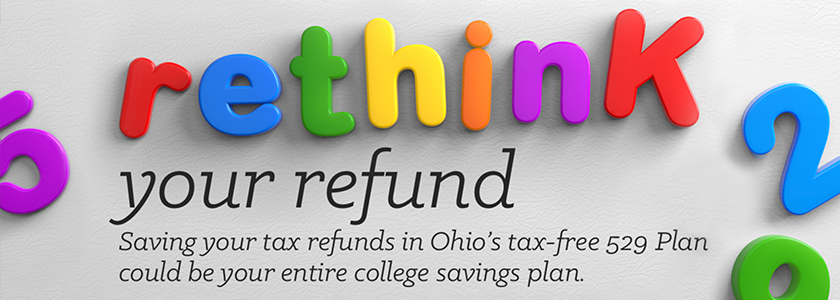Just a friendly reminder: Your 2021 tax returns are due Monday, April 18, 2022, unless you are filing an extension. If you will receive money back, your federal income tax refund can be the foundation of your higher education savings account. By saving some or all of the refund in Ohio’s 529 Plan, CollegeAdvantage, you can be well on your way to covering your child’s higher education costs.
See What Your Tax Refund Can Fund
Your federal and state tax refunds can be a great way to increase your college savings in Ohio’s 529 Plan. If you don’t need those funds to take care of your family’s immediate needs, then consider using them to build up your 529 college savings account. Even adding a small portion of your refund can add up to big savings down the road.
The average 2020 federal tax refund for Ohioans is $2,059. By adding $2,059 a year to an Ohio 529 account, you could cover almost 29% of college costs at an Ohio public university, based on 17 years at 6% growth. If you’d like to crunch the numbers for yourself, use these numbers in our College Savings Estimator tool. Please note that this is an example for illustrative purposes only. For additional advice, consult with your legal, financial, tax, or other advisor.
You can work with different contributions amounts and see how those numbers can add up with the College Savings Planner. Or you can use the tool to see what your estimated 529 account total could be if you deposited monthly automatic contributions, or increased the dollar amount or frequency of your 529 contributions. Every amount contributed, whether big or small, can help you reach your savings goal.
Ohio’s 529 Plan offers tools like this and the Cost of Waiting Tool and The Tax Benefit Tool to create the college savings plan that works best for your family.
529 Plan Tax Advantages
There are many reasons why to save for your child’s future higher education in Ohio’s 529 Plan, especially the tax benefits.
First, earnings in a 529 plan are tax-free, so all investment growth is yours to cover college costs.
Second, 529 plan withdrawals to cover qualified higher education expenses are tax-free at federally accredited programs. These expenditures include tuition; room and board when the beneficiary is enrolled at least half-time; mandatory fees; computer equipment and related technology as well as internet services; books, supplies and equipment related to enrollment and classes; and certain expenses for a special-needs student. Room and board costs also include rent for off-campus residency and groceries (non-taxable items only), provided these costs are equal or less than the same room and board allowances from the accredited school. Recently, certain qualified expenses for U.S. Labor Department accredited apprenticeships can now be paid with tax-free 529 withdrawals. Also, student loan repayment is now a qualified withdrawal for 529 plans. Any student loan that qualifies for the federal student loan income tax deduction can now be paid with a 529 distribution. There is a $10,000 lifetime limit per 529 beneficiary. However, an additional $10,000 can be used to repay qualified student loans for each of the beneficiary’s siblings.
For tax purposes, the burden of proof for qualified expenses and withdrawals is placed on you as the account owner. Make sure to retain all documentation of invoices, 529 plan withdrawals, and payments of all qualified higher education expenses, including your beneficiary's off-campus room and board costs.
Third, Ohio residents who contribute to Ohio’s 529 Plan can deduct their contributions from their taxable state income. This deduction amount is $4,000 per year, per beneficiary, with unlimited carry forward, which means that the $4,000 is not a contribution cap. If an Ohio taxpayer contributes more than $4,000 in one year, they can continue to subtract $4,000 per year, per beneficiary, from their State of Ohio taxable income until all the 529 contributions are deducted.
Where Can You Use An Ohio 529 Account?
Ohio’s 529 Plan can be used whatever school comes after high school — whether a four-year college or university, two-year community college or technical school, trade or vocational school, and certificate program. 529 plans can also pay for qualified costs for apprenticeships, including fees, textbooks, supplies, and equipment, which includes required trade tools. The apprenticeship program must be registered with the Secretary of Labor’s National Apprenticeships Act in order to use a 529 plan withdrawal. Interested parties can check the U. S. Labor Department’s search tool to confirm that a program is eligible.
And just because you save in Ohio’s 529 Plan, it does not meant that your child can only go to an Ohio school, although there are many great public and private higher education institutions throughout the state. A 529 account can be used at any federally accredited institution nationwide. That means that while you are saving with Ohio’s 529 Plan, your child can choose to use those funds at an eligible post-secondary education institution across the U.S. If the school has a Federal School Code on the Free Application for Federal Student Aid (FAFSA), then you can withdrawal tax free your 529 funds to pay for the qualified higher education expenses at that school.
Set Your Savings Strategies
It’s never too late or too early to start saving for your child’s future college costs. No matter how old your child is, Ohio’s 529 Plan has some suggestions on 529 account savings strategies. For instance, if your child is a baby to toddler, it is a fantastic time to start saving for future higher education expenses to take advantage of compound interest. During kindergarten through elementary school, disappearing expenses like day care costs allow you to redirect those dollars to your college savings plan. When your child enters middle school and high school, you may need to increase your contributions. Even if your child is about to start or has even started college, the tax-free earnings, tax-free withdrawals, and the state income tax deduction for Ohioans can still build up the 529 account.
Ready to rethink your refund and open an account with Ohio’s 529 Plan? Visit Ohio’s 529 Plan online to start saving today for your child’s future education. An investment in a 529 plan is an investment in your child as every dollar saved today is a dollar that doesn’t have to be borrowed later. A 529 account can be used for whatever school comes after high school. Learn, plan, and start with Ohio’s 529 Plan today at CollegeAdvantage.com.
This article was originally posted in March 2019 and has been updated to reflect new information for 2022.


















